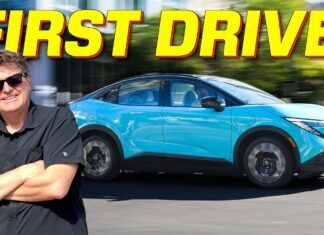If you’re still in the market for an EV, the 2026 Hyundai Ioniq 5 just got a major price drop.
As electric cars go, the Hyundai Ioniq 5 has broadly gone down as a sales success. In fact, its year-to-date sales are up 36% from the first nine months of 2024, and its September sales alone were up 152% to 8,408 units. We all know why, of course: The federal EV tax credit ended on September 30, and boy if Hyundai dealers weren’t promoting these cars to no end to play on folks’ fear of missing that sweet $7,500 incentive. Now the tax credit is gone, however, so you would think prices would head to the stratosphere as MSRPs effectively increase by 20% or so overnight. Hyundai has other ideas, as pricing for the 2026 Hyundai Ioniq 5 actually just dropped between $7,600 and a whopping $9,800 from the 2025 model year.
At the entry-level end of the spectrum, the 2026 Hyundai Ioniq 5 SE RWD Standard Range with 168 horsepower now starts at a flat $35,000. With destination charges added, it’s $36,600, which makes it a hell of a deal even without the federal EV tax credit. Keep in mind, too, that state tax credits may still be in play, so you could still shave some of that price tag down a little further.
The SEL models — the bulk sellers in the Ioniq 5 range — see the biggest discount of all. The RWD models get a $9,800 drop to $49,600 ($51,200 with destination), while the AWD version now goes for $53,100 ($54,700 with destination).
Hyundai offered up similarly substantial price cuts on the top-end Limited and the off-road-minded XRT of $9,225, for starting MSRPs of $55,900 and $57,100 respectively, with the $1,600 freight charge included. On top of straight-up slashing prices across the board, Hyundai is now offering up dual-amperage Level 1/Level 2 combination chargers with every 2026 Ioniq 5, so you get a little bit of added value there.
Rounding out the yearly changes, pricing is really the headline here. There’s a new Sage Silver Matte color, while Vibrant Ultimate Red and Cosmic Blue Pearl are now available across the whole lineup. No pricing details are available for the hot Ioniq 5 N yet, so we may see some deals there…or perhaps not, depending on how Hyundai wants to handle the loss of the federal tax credit on that particular model.
If you’re wanting to get a leftover 2025 Ioniq 5 but missed the tax credit deadline, don’t fret: Hyundai is still offering a $7,500 cash incentive on those, too.
Will this force other EV makers to respond in kind? …We’ll see.
So, why is Hyundai doing this now? The most apparent answer, at first glance, is that Hyundai doesn’t want to lose its sales momentum. That’s particularly true as it shifted more Ioniq 5 production to its new Georgia Metaplant. In its official statement, the company says it is doing this as “part of a broader strategy to maintain the Ioniq brand’s leadership in the electric vehicle space while responding to shifting consumer expectations and competitive pressures.” In other words, they’re making it cheaper to keep it a compelling option as pretty much everyone expects EVs to get even more blindingly expensive in the face of the US government pulling taxpayer funds away from electric car subsidies.
“This pricing realignment reflects our commitment to delivering exceptional technology and innovation without compromise,” says Hyundai Motor North America CEO Randy Parker.
On one hand, Hyundai stepping up to drop prices in greater amounts than the tax credit gave in the first place could be seen as, to date myself here, “a bro move”.
On the other…why couldn’t the automaker do this when the federal EV tax credit was still in play, then? Profitability is the name of the game at the end of the day, of course, and electric models have been hugely expensive for automakers to develop and build. Ford, for example, lost $1.3 billion on its “Model e” electric division in Q2 2025, despite more than doubling its overall revenue.
Hyundai could well be going into the red on each sale to keep volumes up in the short-term while it makes adjustments to production down the road. That said, the timing makes you wonder whether this sort of “readjustment” was only possible right now, or if we could have seen even greater savings for folks wanting to take the plunge on a new EV…and exactly how much meaning “MSRP” has when certain automakers (definitely not limited to Hyundai) can shift prices by four figures or more at a stroke. And I haven’t even mentioned how such moves affect used car pricing.
Long story short: If you’re in the market for an EV, the 2025 and 2026 Hyundai Ioniq 5 should still be a competitive option, especially considering you don’t need a $7,500-plus tax liability to claim maximum savings with cash incentives and lower MSRPs — so you can still score a deal.
























